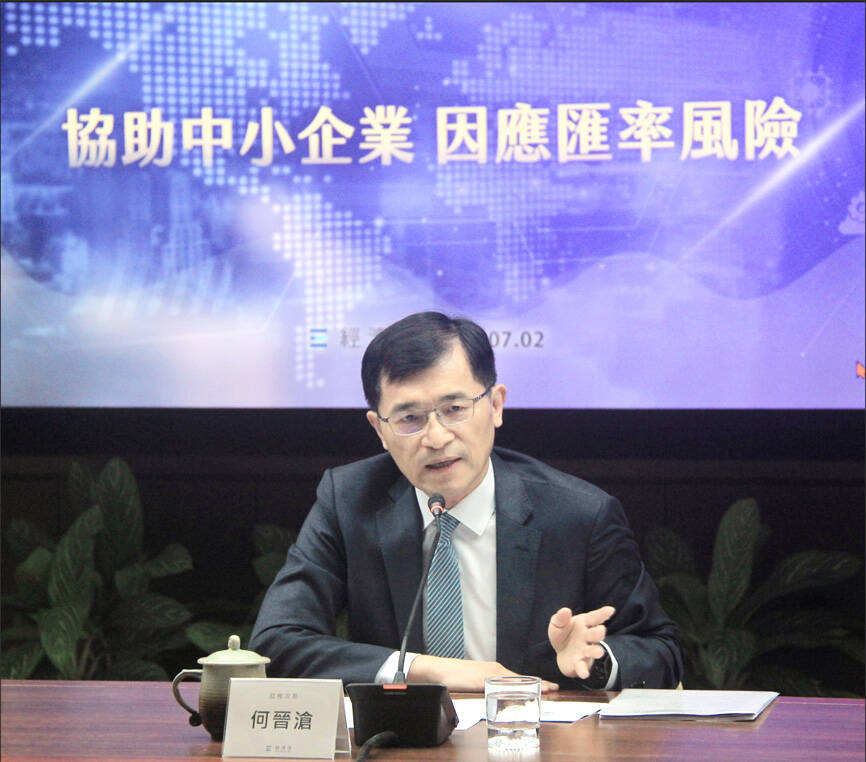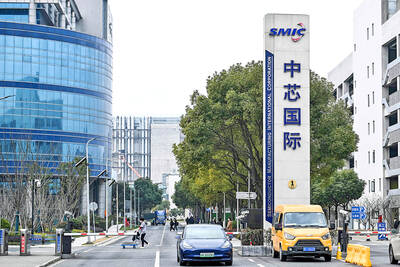The Ministry of Economic Affairs would continue to offer the nation’s small and medium-sized enterprises (SMEs) financial assistance, and encourage the use of hedging tools against foreign exchange volatility, as the sharp appreciation of the New Taiwan dollar since early May has seriously affected their operations, Deputy Minister of Economic Affairs Ho Chin-tsang (何晉滄) said yesterday.
There are 46,000 export-oriented SMEs in Taiwan, most of which are in the manufacturing industry, and 80 percent of them quote prices in US dollars, Ho said at a news conference in Taipei.
As SMEs are highly vulnerable to exchange rate fluctuations, the ministry would step up promotion of three hedging tools, including foreign exchange forward contracts, foreign exchange options and natural hedging, while helping them connect with banks to explore alternative hedging instruments, he said.

Photo courtesy of the Ministry of Economic Affairs
Firms most affected by the sharp appreciation of the NT dollar are those in the metal, machine tools, machinery, textiles, plastics and rubber, auto parts, food, electronic components, and information and communications industries, he said.
The ministry has set up a foreign exchange response team, which is expected to run for at least three months to offer SMEs clear countermeasures, accessible consultation and practical tools they can use when needed, Small and Medium Enterprise Startup Administration Director-General Lee Guann-jyh (李冠志) said.
The team is mainly composed of personnel from the administration, the Industrial Development and International Trade administrations, Lee said.
The ministry earlier yesterday held a meeting with eight state-run banks — Bank of Taiwan Co (臺灣銀行), Land Bank of Taiwan Co (土地銀行), Taiwan Cooperative Bank Ltd (合作金庫), First Commercial Bank Co (第一銀行), Hua Nan Commercial Bank Ltd (華南銀行), Chang Hwa Commercial Bank Ltd (彰化銀行), Mega International Commercial Bank Co (兆豐銀行) and Taiwan Business Bank Co (台灣企銀) — to discuss how to assist SMEs.
The ministry would continue talks with the banks on further lowering fees for SMEs applying for financial aid, it said.
In April, the ministry announced it would offer up to NT$6 billion (US$206.8 million) in loan guarantees for SMEs directly affected by US tariffs, and an additional NT$5 billion for those indirectly affected.
Each SME could receive up to NT$60 million in guarantees and large firms could qualify for up to NT$100 million, while firms with fewer than 30 employees could receive loan guarantees of up to NT$35 million, it said.
The Small and Medium Enterprise Credit Guarantee Fund of Taiwan (信保基金) provided about NT$159 billion in loan guarantees to small, medium and micro-sized enterprises last month, up 7.8 percent from NT$147.5 billion in May, a fund official told the Taipei Times by telephone.
That represented a 5 percent increase to NT$829.4 billion in the first half of this year, up from NT$790.2 billion a year earlier, the official said on condition of anonymity.

NO BREAKTHROUGH? More substantial ‘deliverables,’ such as tariff reductions, would likely be saved for a meeting between Trump and Xi later this year, a trade expert said China launched two probes targeting the US semiconductor sector on Saturday ahead of talks between the two nations in Spain this week on trade, national security and the ownership of social media platform TikTok. China’s Ministry of Commerce announced an anti-dumping investigation into certain analog integrated circuits (ICs) imported from the US. The investigation is to target some commodity interface ICs and gate driver ICs, which are commonly made by US companies such as Texas Instruments Inc and ON Semiconductor Corp. The ministry also announced an anti-discrimination probe into US measures against China’s chip sector. US measures such as export curbs and tariffs

The US on Friday penalized two Chinese firms that acquired US chipmaking equipment for China’s top chipmaker, Semiconductor Manufacturing International Corp (SMIC, 中芯國際), including them among 32 entities that were added to the US Department of Commerce’s restricted trade list, a US government posting showed. Twenty-three of the 32 are in China. GMC Semiconductor Technology (Wuxi) Co (吉姆西半導體科技) and Jicun Semiconductor Technology (Shanghai) Co (吉存半導體科技) were placed on the list, formally known as the Entity List, for acquiring equipment for SMIC Northern Integrated Circuit Manufacturing (Beijing) Corp (中芯北方積體電路) and Semiconductor Manufacturing International (Beijing) Corp (中芯北京), the US Federal Register posting said. The

India’s ban of online money-based games could drive addicts to unregulated apps and offshore platforms that pose new financial and social risks, fantasy-sports gaming experts say. Indian Prime Minister Narendra Modi’s government banned real-money online games late last month, citing financial losses and addiction, leading to a shutdown of many apps offering paid fantasy cricket, rummy and poker games. “Many will move to offshore platforms, because of the addictive nature — they will find alternate means to get that dopamine hit,” said Viren Hemrajani, a Mumbai-based fantasy cricket analyst. “It [also] leads to fraud and scams, because everything is now

MORTGAGE WORRIES: About 34% of respondents to a survey said they would approach multiple lenders to pay for a home, while 29.2% said they would ask family for help New housing projects in Taiwan’s six special municipalities, as well as Hsinchu city and county, are projected to total NT$710.65 billion (US$23.61 billion) in the upcoming fall sales season, a record 30 percent decrease from a year earlier, as tighter mortgage rules prompt developers to pull back, property listing platform 591.com (591新建案) said yesterday. The number of projects has also fallen to 312, a more than 20 percent decrease year-on-year, underscoring weakening sentiment and momentum amid lingering policy and financing headwinds. New Taipei City and Taoyuan bucked the downturn in project value, while Taipei, Hsinchu city and county, Taichung, Tainan and Kaohsiung